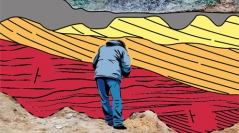

 Geodiversitas
45 (16) - Pages 449-478
Geodiversitas
45 (16) - Pages 449-478The paleontological locality of Mauvières (Indre-et-Loire, France) is located in the South-West part of the Paris Basin, 55 kilometers North-West of the city of Tours. This site is a quarry that is periodically exploited for Miocene sands and shelly sands. In 2000, L. Ginsburg and his collaborators identified a rich fauna of continental vertebrates from the early Orleanian (=early-middle Burdigalian, Orleanian European Land Mammal Age [ELMA] MN3 biozone). In this first study, the geological and taphonomic contexts were not precised. In 2020, following new excavation work in the quarry, a new study focusing on the missing contextual data started has been launched. The geological succession includes several distinct formations: Paleogene marls, Lower Miocene continental sands, Lower to Middle Miocene marine carbonates and Upper Neogene superficial deposits. Their faciological analysis highlights a direct relationship between the Neogene sedimentation and local tectonic controls. In parallel, new paleontological data from the different fossiliferous levels were collected, including: Chondrichthyes and Osteichthyes teeth (Rupelian or Early Miocene) reworked in the lower Orleanian continental sands, twenty-one additional taxa in the early Orleanian vertebrate assemblages (MN3) and a terrestrial mammal assemblage from the middle-late Orleanian (=Langhian standard age, biozone MN4 à MN5) reworked in the marine Langhian conglomerate. In addition, the biostratigraphic position of Early Miocene terrestrial vertebrates have been clarified (Ligerosaurus pouiti (Augé, Bailon & Malfay, 2003)) and confirmed (Ballusia hareni (Ginsburg, 1989), Ursavus isori Ginsburg & Morales, 1998 and Hemicyon gargan Ginsburg & Morales, 1998). All these new data (geological, paleontological and taphonomic) confirm that the paleontological site of Mauvières should be included in the national list of French geological heritage sites to be preserved.
Cenozoic, Touraine, tectonics, faunal assemblage, taphonomy